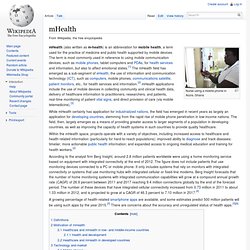

NextDrop. NTHC.pdf (application/pdf-Objekt) mHealth. Nurse using a mobile phone in Accra, Ghana mHealth (also written as m-health) is an abbreviation for mobile health, a term used for the practice of medicine and public health supported by mobile devices.

The term is most commonly used in reference to using mobile communication devices, such as mobile phones, tablet computers and PDAs, for health services and information, but also to affect emotional states.[1] The mHealth field has emerged as a sub-segment of eHealth, the use of information and communication technology (ICT), such as computers, mobile phones, communications satellite, patient monitors, etc., for health services and information.[2] mHealth applications include the use of mobile devices in collecting community and clinical health data, delivery of healthcare information to practitioners, researchers, and patients, real-time monitoring of patient vital signs, and direct provision of care (via mobile telemedicine).[3]
One Laptop per Child. ICTs in Education: The “One Laptop Per Child” Program – Right Intentions but Flawed Approach. In 2005, Nicholas Negroponte, the founder of MIT’s Media Labs, announced the One Laptop per Child (OLPC) program at the World Economic Forum.

The concept was simple and appealing: Innovate a $100 laptop and distribute it to children in the developing world. No one can argue the power of getting kids access to computers/internet, and as a result, connectivity to the world and huge resource of information. But as the OLPC program has found out over the years, there is more to the success of Information and Communications Technologies (ICTs) in Education, than just handing out computers to kids, and expect it to works its magic on its own. For starters, the premises and approach of the OLPC program are fundamentally flawed. ICTs for Development.